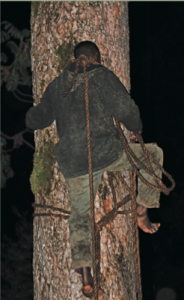Ethiopia is the leading producer of honey in Africa, and the tenth largest producer in the world. Traditional beekeeping has been practiced for thousands of years in Ethiopia. The Harenna forest is known for its production of organic forest honey. The indigenous people of the area possess extensive knowledge of tree species and their value for beekeeping. The Harenna forest is endowed with various tree species that make excellent hives, which are made from hollowed out tree trunks. Trees are assessed for durability of the timber, ease of production, and availability and attractiveness of wood to the bees. Bees are picky and each beekeeper has a preferred method of attracting bees. Between 10 and 20 hives can be made from a single tree. Each beekeeper owns numerous suspended hives, which have been passed from generation to generation. Trees are marked as to signify use of a hive, and tall trees with bare trunks are preferred as this acts as a defense against climbing honey badgers.
At the end of the dry season (late May to early July, and again in late November), honey is harvested. Honey is harvested at night when the bees are less active. Wearing no protective clothing, and consequently enduring many stings, the beekeeper climbs the trunk with incredible speed using only a single rope. Smoke from bound lichen is used to subdue the bees as honey is placed into a hardened leather bag. If the time of year is right, you can be a part of this process and taste the fresh honey as its harvested. This is best done from the village of Rira, found at the base of the Harenna escarpment.
It is highly recommended to make a booking at least two weeks in advance so that beekeepers can identify and arrange available hives. This can also be organized through the Bale Mountain Lodge. For contact information see the directory.

